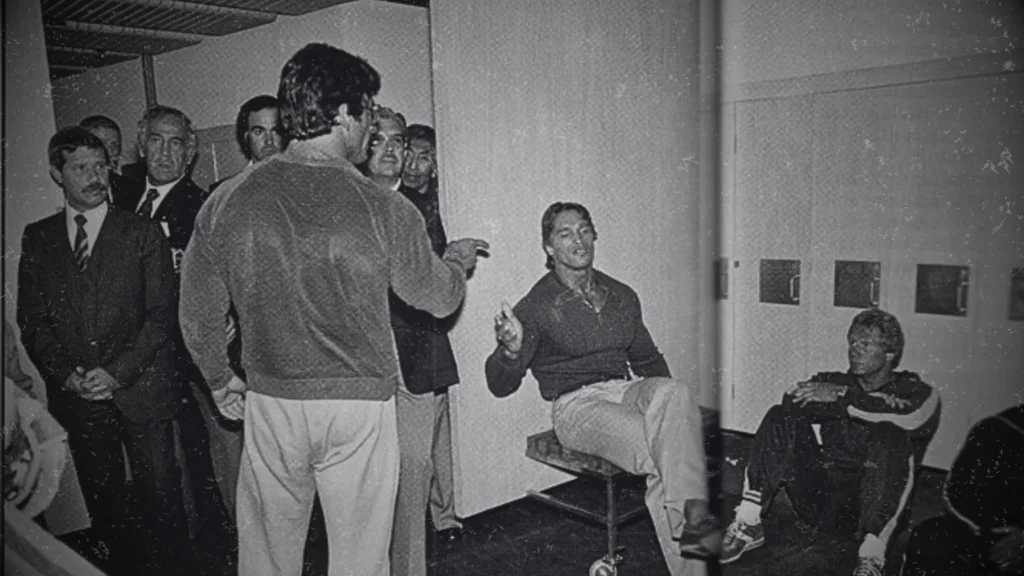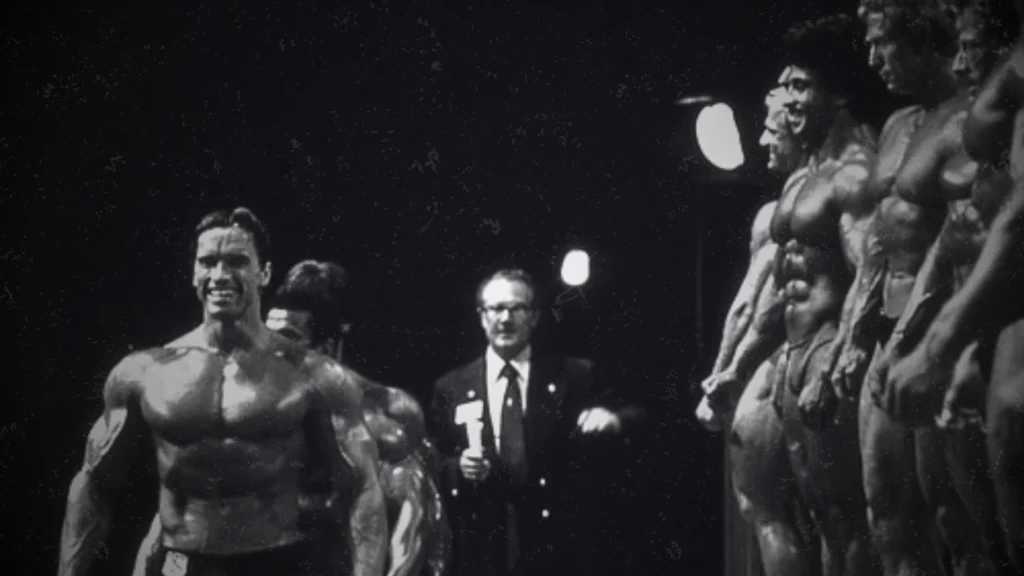The 1980 Mr. Olympia remains bodybuilding’s most disputed competition. 40% of the 2,000 spectators booed loudly when they heard the winner’s name. This prestigious event made history by moving beyond U.S. shores to Australia’s iconic Sydney Opera House.
Nobody saw what came next. Arnold Schwarzenegger, the six-time champion who stepped away in 1975, stunned everyone with his comeback announcement just 24 hours before the show. His surprise entry stirred heated debates since he reached only 80-90% conditioning of his peak form. The situation grew more complex as several judges turned out to be Arnold’s close friends. Meanwhile, the current champion Frank Zane battled a serious injury, and Mike Mentzer, known for his perfect scores, stood ready to claim the crown.

Arnold’s Secret Preparation for the 1980 Mr. Olympia
The summer of 1980 brought Arnold Schwarzenegger back to World Gym in Santa Monica. His presence sparked rumors about a possible comeback. The Austrian Oak quietly prepared for what would become one of bodybuilding’s most talked-about moments.
The former champion cleverly hid his competition prep behind his training for Conan the Barbarian. He wanted to build himself up from 215 pounds to a solid 230 pounds. Other bodybuilders noticed his intense workout routine, but Arnold skillfully brushed off their questions by saying the movie role needed him to be “ripped”.
Arnold’s announcement to compete just one day before the contest threw the bodybuilding world into chaos. He had traveled to Australia as a CBS commentator. His last-minute entry shocked the competitor ranks, and 40% of the 2,000 spectators showed their disapproval by booing loudly.
Arnold’s preparation at World Gym took an unusual approach:
- He trained twice daily with rotating partners, including Franco Columbu and Jusup Wilkosz
- He used surprisingly light weights during workouts
- He kept his energy up with Diet Pepsi and seedless grapes during sessions
A major setback hit when Arnold took a cortisone shot for his shoulder injury that caused unexpected water retention. His friend Franco Columbu saw Arnold’s condition in Sydney and immediately said, “You idiot, how are we going to get the water out?”
Arnold’s physique showed mixed results. His chest, back, and biceps returned to their past glory, but his legs, triceps, and midsection lacked definition. Experts believed he reached 80-90% of his peak condition. The night before competition, Arnold spent hours in his hotel room trying to shed excess water. He finally collapsed from exhaustion early in the morning.
Inside the Sydney Opera House Showdown
Tension filled the Sydney Opera House as sixteen competitors stepped onto the stage on October 4, 1980. The mandatory poses started with IFBB head judge Oscar State calling out each pose with military precision.
Each top contender showed unique strengths and weaknesses:
- Arnold’s biceps stole the show, but his legs were nowhere near as defined
- Frank Zane looked shredded yet weighed less than his previous year
- Chris Dickerson’s symmetry stood out despite his smaller arms
- Boyer Coe packed impressive mass with standout arm development
- Mike Mentzer brought size but lacked his usual polish
A seven-judge panel that included big names like Albert Busek and Reg Park used a three-round system. The final scores raised eyebrows – Arnold scored 295 points, Frank Zane followed with 291, and Chris Dickerson landed at 290.
The results announcement sparked chaos in the packed Opera House. Much of the 2,000-strong crowd – about 40% – erupted in loud boos. Chris Dickerson jumped off stage shouting “I can’t believe it!” as the atmosphere grew hostile.
CBS Television’s response added fuel to the fire. The network refused to air the contest because they believed Arnold’s win was fixed. CBS executives even showed Chris Dickerson the footage later to prove what they saw as questionable judging.
Drama continued backstage after the show. Frank Zane’s trophy ended up damaged, though he later claimed he dropped it by accident. Boyer Coe didn’t hold back either, taking shots at the winner’s physique and saying the champion had “legs that looked like they belonged in a chicken nest”.

The Mike Mentzer vs Arnold Schwarzenegger Rivalry
The tension between Mike Mentzer and Arnold Schwarzenegger exploded at the pre-contest meeting. This moment sparked one of bodybuilding’s most infamous rivalries. The scene unfolded in front of nearly 50 athletes and officials who witnessed this unprecedented confrontation.
The Pre-Contest Confrontation
Arnold lit the fuse with a controversial comment about Mentzer’s physique. He claimed that “everyone knew he lost last year because he had a belly”. Mentzer’s reaction was immediate – he charged toward Arnold. The usually confident Arnold retreated to a corner. “He went from being a frantic, hysterical adolescent to shrinking away like an injured child,” Mentzer would later recall.
Their rivalry stemmed from completely different approaches to bodybuilding:
- Mentzer’s High-Intensity Training (HIT):
- 30-minute sessions, four times weekly
- Focus on maximum muscle stimulation
- Emphasis on recovery between workouts
- Arnold’s Volume Training:
- Five to six hours daily
- Two training sessions per day
- Minimal rest between workouts
Mentzer’s fifth-place finish led to a decision that stunned the bodybuilding world. He announced his retirement from competitive bodybuilding. His decision sparked a chain reaction as several competitors boycotted future competitions.
The controversy reached beyond the competition floor. CBS executives refused to produce the event recordings after returning to the US. They believed the contest favored Arnold unfairly. The rivalry’s effects lingered, and according to fellow competitor Tom Platz, Mentzer never got over the whole ordeal.
This confrontation changed bodybuilding forever. It transformed how the sport handled judging criteria and competitor behavior. For Mentzer, this meant more than losing a competition – it showed how commercialization had taken over a sport he loved deeply.
Behind the Political Curtain
The 1980 Mr. Olympia had more going on backstage than most people knew. This competition’s political dynamics ended up reshaping professional bodybuilding forever.
The makeup of the judging panel raised red flags about fairness. Many people saw a conflict of interest because Arnold had close personal connections to four of the seven judges.
The panel included:
- Albert Busek – Arnold’s friend from his early days in Germany
- Reg Park – Arnold’s mentor and friend since age 19
- Mits Kawashima – A close associate who often hosted Arnold in Hawaii
- Dan Howard – From the USA contingent
These connections prompted Bill Pearl, the designated head judge, to step down after he revealed he had helped Chris Dickerson prepare. “I would have placed Arnold fifth,” Pearl stated bluntly.
Television coverage added another layer of controversy. CBS Sports made a substantial investment to travel to Sydney and capture what they hoped would be a historic broadcast. Their plans took an unexpected turn. The controversial decision led CBS executives to take unprecedented action – they scrapped the entire production.
CBS executives believed the contest favored Arnold unfairly. They even showed Chris Dickerson the footage to demonstrate what they saw as questionable judging decisions.
IFBB’s Response to the Controversy
The International Federation of Bodybuilding acted quickly and decisively. The federation made major changes at the November 1980 IFBB Congress in Manila to prevent future controversies. Their biggest reform took away contest organizers’ power to pick Olympia judges. An independent judging director would now select the panel.
The impact reached the sport’s highest levels. Ben Weider managed to keep his position that Dickerson deserved the title, both publicly and privately. Iron Man magazine faced a unique challenge – they had to edit out explicit language from fan testimonials about the decision.
The political aftermath affected future events. Several top competitors announced they would skip the 1981 Mr. Olympia, including Frank Zane, Boyer Coe, and Mike Mentzer. This turned out to be the last time an American broadcast network would film the Mr. Olympia contest, marking a major change in how mainstream media covered the sport.
Legacy of the 1980 Mr. Olympia
The 1980 Mr. Olympia in Sydney stands as a defining moment that altered the map of professional bodybuilding 40 years later. This controversial showdown left its mark on everything from judging methods to media coverage. IFBB made major reforms at their November 1980 Congress in Manila.
The organization brought significant changes:
- Contest organizers lost their power to pick judges
- Independent judging directors took control
- Scoring criteria became standardized
- Scoring systems gained more transparency
These changes brought a vital shift in bodybuilding competition officiating. IFBB President Ben Weider took personal charge of selecting judges for the 1981 Mr. Olympia.
Professional ranks felt immediate aftershocks. Many top competitors felt let down and boycotted the 1981 Mr. Olympia, which changed the sport’s competitive scene. Frank Zane, Boyer Coe, Mike Mentzer, and Chris Dickerson stayed away from the competition.
The digital world changed dramatically too. CBS Television dropped their expensive production, which ended mainstream network coverage for the Mr. Olympia. This retreat from network TV changed how bodybuilding reached its audience for decades.

Historical Significance in Sport
The 1980 Mr. Olympia’s influence reaches way beyond the reach and influence of its time. Bodybuilding forums worldwide still buzz with heated discussions about this contest. The event raised vital questions about:
Judging Criteria Development:The sport moved toward favoring mass over esthetics after removing the under-200-pound class. This created new standards in professional bodybuilding.
Political Influence:Debates about celebrity and politics in competitive bodybuilding started with this controversy. These discussions still shape today’s conversations about fairness and objectivity.
Professional Standards:IFBB’s response set new standards for managing professional competitions. Modern bodybuilding governance still follows these principles.
’60 Minutes’ news program considered an investigative piece about the contest’s controversial outcome. This showed how one event captured public interest in the sport’s integrity.
The 1980 Mr. Olympia Controversy (Final Words)
The Sydney showdown became a pivotal moment that pushed the IFBB to clean up its act. The organization revamped its judging system afterward, but many believe the damage had already taken root. When legendary competitors like Mentzer, Zane, and Dickerson left the sport, bodybuilding’s credibility took a massive hit.
Arnold’s disputed win marked bodybuilding’s last appearance on mainstream television. The Austrian Oak claimed his seventh Sandow trophy, but the victory came at a high cost. CBS abandoned their expensive production, and bodybuilding missed its shot at wider mainstream acceptance.
This contest shaped modern bodybuilding at its core. The focus moved toward mass over aesthetics, while stricter judging rules emerged. The sport now faces greater scrutiny over political influence – all these changes trace back to that decisive night at the Sydney Opera House. Bodybuilding has evolved substantially since 1980, yet the impact of those controversial moments still affects how competitions are judged, hosted, and seen today.


